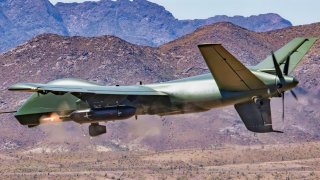Mojave: How Aircraft Carriers Could Become Drone Carriers
Mojave is the first aircraft in its class to take off and land aboard an aircraft carrier – as it did last November in a demonstration with the Royal Navy's Prince of Wales. It can conduct naval missions and sea-based support for joint, conventional, and special operations forces.
Summary: General Atomics Aeronautical Systems (GA-ASI) recently conducted a successful live-fire test of its Mojave unmanned aircraft system (UAS) in the Yuma desert, demonstrating the drone's short takeoff and landing (STOL) capabilities and its effectiveness in engaging targets. The test involved the Mojave equipped with Dillon Aero's DAP-6 Gun Pod Systems, executing multiple passes and expending approximately 10,000 rounds of ammunition. The Mojave is built on the technological foundation of the MQ-9A Reaper and MQ-1C Gray Eagle Extended Range systems, and is designed to operate from diverse terrains and even aircraft carriers. It represents a significant advancement in unmanned aerial technology, emphasizing flexibility in combat and support roles.
Earlier this month, General Atomics Aeronautical Systems (GA-ASI) conducted a live-fire test of its short takeoff and landing (STOL) Mojave unmanned aircraft system (UAS) in the Yuma desert. The Mojave successfully destroyed static targets, and validated the drone's battlefield relevance while reaching another milestone for the demonstrator aircraft.
GA-ASI partnered with Dillon Aero to mount two of its DAP-6 Gun Pod Systems onto the Mojave aircraft. The UAS then performed seven passes across two flights during the demonstration, expending around 10,000 rounds of ammunition as the UAS shredded a variety of targets. It fired around 3,000 rounds per minute.
"Seeing our Mojave perform this live-fire demo really emphasizes the versatility of the Mojave UAS and what it can do," explained GA-ASI President David R. Alexander. "Mojave has the ability to act as a sensor, shooter, and sustainer while mitigating threat environments and vulnerabilities and safeguarding human lives."
The live-fire demonstration took place at Yuma Proving Ground, Arizona, and was funded via GA-ASI’s internal research and development budget.
Meet the Mojave Drone
Built on the proven MQ-9A Reaper and MQ-1C Gray Eagle Extended Range systems, the GA-ASI Mojave was developed to leverage the U.S. Army investments in open architecture modularity, autonomy, and machine learning. The Mojave was first unveiled in 2021, and it builds on the more than seven million flight hours of the MQ-1 Predator, MQ-9 Reaper, and MQ1-Gray Eagle.
It incorporates GA-ASI’s Grey Eagle 25M program's updated avionics, data connections, sensor fusion, and laptop-based ground control station. It has larger wings than its predecessor drones, while it has been equipped with high-lift devices and a 450-HP turbine engine.
Mojave, with its short takeoff and landing (STOL) capability, can take off and land from remote semi-improved surfaces like highways, desert plains, jungle clearings, and even island beaches.
It requires as little as 586 feet to complete a takeoff and 335 feet for short landings.
Aircraft Carrier Operations for the Mojave Drone
Mojave is the first aircraft in its class to take off and land aboard an aircraft carrier – as it did last November in a demonstration with the Royal Navy's Prince of Wales. It can conduct naval missions and sea-based support for joint, conventional, and special operations forces.
The UAS can also quickly land, re-arm, and re-launch from austere sites near non-permissive environments, but with its increased wing surface area, it can carry double the payload of earlier-model aircraft.
Whether it is critical supplies or munitions, Mojave can handle loads of up to 3,600 lb (1,633 kg), the equivalent of sixteen AGM-114 Hellfire missiles. Additionally, the drone can be equipped with a highly advanced sensor suite, including EO/IR, a Synthetic Aperture Radar/Ground Moving Target Indicator (SAR/GMTI), Signals Intelligence (SIGINT), and contested logistic pods capable of carrying 500 pounds of cargo on each wing to support land or maritime missions.
Author Experience and Expertise: Peter Suciu
Peter Suciu is a Michigan-based writer. He has contributed to more than four dozen magazines, newspapers, and websites with over 3,200 published pieces over a twenty-year career in journalism. He regularly writes about military hardware, firearms history, cybersecurity, politics, and international affairs. Peter is also a Contributing Writer for Forbes and Clearance Jobs. You can follow him on Twitter: @PeterSuciu.
You can email the author: [email protected].
Image Credit: General Atomics.

